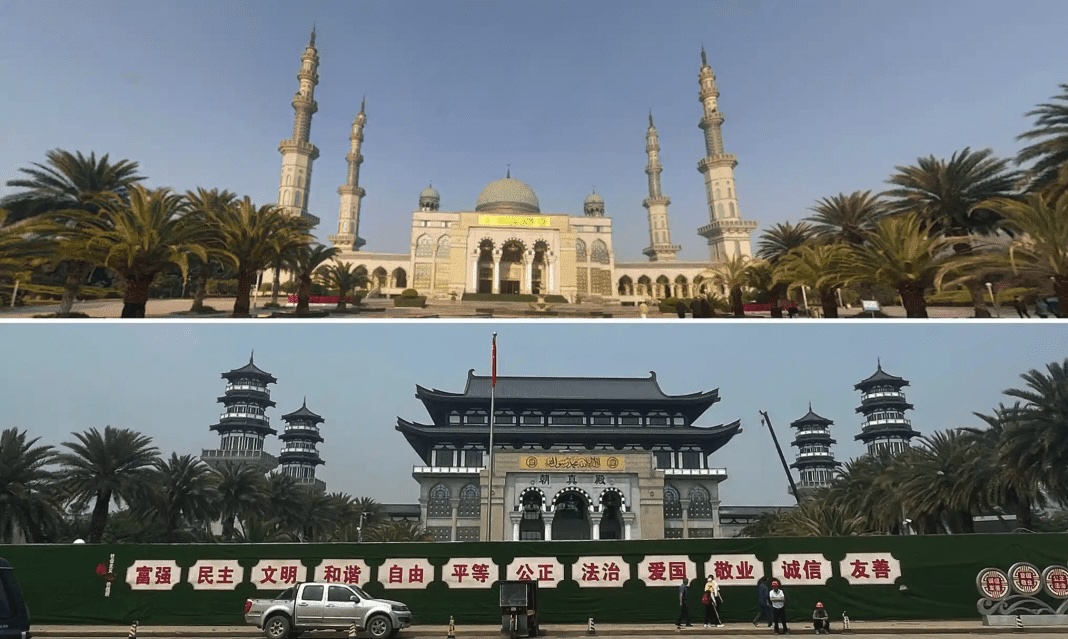Archive for Language and religion
September 21, 2024 @ 9:16 pm· Filed by Victor Mair under Language and kinship, Language and religion
Not only is it hard to spell, few people know what it means.
As I mentioned in earlier posts, on my trip to SLC three or four days ago, I fulfilled three of my childhood dreams: 1. float in the Great Salt Lake; 2. hear the Mormon Tabernacle Choir in person; 3. visit the Family Research Center of The Church of Jesus Christ of Latter-day Saints, the largest genealogical library in the world (I remember that when I was a graduate student more than half a century ago, Mormon archivists spent two years filming every Chinese genealogical record in the Harvard-Yenching Library; at that time I did not understand why they would do that, now I do).
I was chatting with some people in the lobby of the motel where I was staying, and a young man in his early twenties asked me why I wanted to do #3, visit the genealogy research center of The Church of Jesus Christ of Latter-day Saints (he himself was a Mormon).
Read the rest of this entry »
Permalink
September 13, 2024 @ 9:10 pm· Filed by Victor Mair under Language and music, Language and religion, Names
Mark Swofford stumbled upon this church in Taipei:

Read the rest of this entry »
Permalink
August 31, 2024 @ 4:30 am· Filed by Victor Mair under Announcements, Books, Language and history, Language and religion, Language and society, Manuscripts, Vernacular
Just published is a volume edited by David Holm, Vernacular Chinese-Character Manuscripts from East and Southeast Asia (De Gruyter), in their Studies in Manuscript Cultures series.
The book has chapters on Hokkien, Cantonese, Vietnamese, Yao, Zhuang, and other Tai-speakers who use Chinese-based vernacular scripts.
Previously announced on Language Log
here.
Read the rest of this entry »
Permalink
August 18, 2024 @ 6:04 pm· Filed by Victor Mair under Announcements, Language and art, Language and philosophy, Language and religion, Lexicon and lexicography, Vernacular
Sino-Platonic Papers is pleased to announce the publication of its three-hundred-and-fifty-third issue: "Speaking and Writing: Studies in Vernacular Aspects of Middle Period Chinese Culture" (pdf), edited by Victor H. Mair (August, 2024).
Foreword
The three papers in this collection were written for my seminar on Middle Vernacular Sinitic (MVS). They cover a wide variety of topics, from epistolary style to social mores, to philosophy and religion. They reveal how a vernacular ethos informs the thought and life of men and women from different social classes and distinguishes them from those who adhere to a more strictly classical outlook. Although they are on quite dissimilar subjects, this trio of papers harmonize in their delineation of the implications of vernacularity for belief and perception. Taken together, they compel one to consider seriously what causes some people to tilt more to the vernacular side and others to cling to classicism. While the authors of these papers do not aim to arrive at a common conclusion on the meaning of the vernacular-classical divide, the readers who probe beneath the surface of all three papers will undoubtedly find facets that refract and reflect themes that bind them into a unified body of inquiry.
Read the rest of this entry »
Permalink
August 15, 2024 @ 3:55 pm· Filed by Victor Mair under Announcements, Emojis and emoticons, Language and religion, Language reform, Vernacular, Writing systems
Sino-Platonic Papers is pleased to announce the publication of its three-hundred-and-fifty-second issue: "Dramatic Transformations of Sinography in East Asia and the World" (pdf), edited by Victor H. Mair (August, 2024).
Foreword
The three papers in this collection were written for my “Language, Script, and Society in China” course during the fall semester of 2023. All three of them are concerned with radical changes made to Sinographic script during its adjustment to modernity.
Read the rest of this entry »
Permalink
July 4, 2024 @ 6:28 pm· Filed by Victor Mair under Announcements, Borrowing, Etymology, Language and archeology, Language and religion, Typography
Sino-Platonic Papers is pleased to announce the publication of its three-hundred-and-fifty-first issue: "Placing Western Coins Near the Deceased in Ancient China: The Origin of a Custom," by Pin LYU:
ABSTRACT: This article traces the custom in ancient China of placing Western coins in proximity to corpses during burial. Academic attention has focused on the origin of the custom since Marc Aurel Stein initially connected the finding in Turfan of Western coins placed in the mouths or on the eyes of the corpses with Charon's obol, the ancient Greek coin that, similarly placed, paid Charon to ferry the dead to the underworld. Some scholars agreed with Stein's proposal, while others suggested that it was instead a traditional Chinese funerary ritual, unrelated to Greece. This article moves away from over-reliance on written sources and aims at uncovering the patterns underlying this custom, through the collection and analysis of available archaeological material. Results indicate that the custom possibly originated in the Hellenistic practice of Charon's obol and then traveled to China with Sogdian immigrants, developing into a regional funeral ritual in Turfan.
Read the rest of this entry »
Permalink
June 17, 2024 @ 7:23 am· Filed by Victor Mair under Announcements, Language and religion, Philology
Sino-Platonic Papers is pleased to announce the publication of its three-hundred-and-forty-ninth issue — Benjamin Porteous, "Reading Genesis 22 and Analects 18 in Late Antiquity":
ABSTRACT: This paper compares modes of scriptural interpretation from two ends of the Eurasian landmass in the late antique period (400–600 CE). Juxtaposing midrashim on Genesis with the Lunyi yishu 論語義疏, a famous expository commentary on the Confucian Analects, the paper argues that the difference between late-antique Confucian and Jewish commentarial practice lies in differing senses of responsibility for the sacred text. The Lunyu yishu curates the full Analects text, while midrashim presuppose a reader who turns elsewhere for the full version of the Hebrew Bible. The paper provides full typologies of commentarial technique in the midrashim and the Lunyu yishu; this is designed to assist comparison and further understanding of the practice of medieval Chinese commentary.
Read the rest of this entry »
Permalink
June 3, 2024 @ 7:10 am· Filed by Victor Mair under Language and religion, Logic, Rhetoric
It's surprising (at least to me) that this seemingly oxymoronic belief is so widespread. Check out this quote from Christopher Hitchens in “Religion Kills” from his 2007 book God Is Not Great: How Religion Poisons Everything:
…the Greek demigod Perseus was born when the god Jupiter visited the virgin Danae as a shower of gold…The god Buddha was born through an opening in his mother’s flank. Catlicus the serpent-skirted caught a little ball of feathers from the sky and hid it in her bosom, and the Aztec god Huitzilopochtli was thus conceived. The virgin Nana took a pomegranate from the tree water by the blood of the slain Agdestris, laid it in her bosom, and gave birth to the god Attis. The virgin daughter of a Mongol king awoke one night and found herself bathed in a great light, which caused her to give birth to Genghis Khan. Krishna was born of the virgin Devaka. Horus was born of the virgin Isis. Mercury was born of the virgin Maia. Romulus was born of the virgin Rhea Sylvia.
Read the rest of this entry »
Permalink
May 28, 2024 @ 10:44 pm· Filed by Victor Mair under Language and art, Language and religion
Before and after the recently completed sinicization of the Grand Mosque of Shadian, Yunnan, in southwest China:

Read the rest of this entry »
Permalink
May 28, 2024 @ 12:50 pm· Filed by Victor Mair under Etymology, Language and religion, Phonetics and phonology, Writing systems
[This is a guest post by Chris Button about xiān 祆 (usually defined in English as:
Xiān: húshén yě. [Pinyin]
Xian is the god of the
foreigners.
The two components of the 祆 glyph are shì
示/礻 ("show, reveal, manifest; spirit") and tiān天 ("sky, heaven, celestial").
Although hugely important in the history of religions in China, the etymology of xiān 祆 is highly elusive. Through close attention to the phonology of the glyph and its components, Chris aims to ferret out the source of a possible loanword.]
============
I've been pondering over 祆 EMC xɛn "Ahura Mazda, Zoroastrianism" for a while and its possible relationship with 天 EMC tʰɛn "heaven" (compare 忝 EMC tʰɛmˀ with 天/祆 as phonetic in the top half).
Read the rest of this entry »
Permalink
May 1, 2024 @ 8:23 pm· Filed by Victor Mair under Language and religion, Translation
[This is a guest post by IA]
Speaking of
religion and language, among the various '
sacred name Bibles' the most interesting I've seen is called the Literal English Version. (Though there is certainly nothing 'literal' about it in the sense of Young's Literal Translation.) It's online
here.
Here are some quotes from it.
Read the rest of this entry »
Permalink
April 28, 2024 @ 6:02 am· Filed by Victor Mair under Language and religion, Transcription, Translation
Serious questions about "religion" in Sinitic
Below the fold is for advanced specialists in Chinese philology, theology, and lexicography. Even for them, it is recommended that readers prepare themselves by reviewing "Spelling with Chinese character(istic)s, pt. 4" (7/4/16).
[This is a guest post by IA]
Read the rest of this entry »
Permalink
April 2, 2024 @ 5:52 pm· Filed by Victor Mair under Borrowing, Language and religion
Read the rest of this entry »
Permalink

